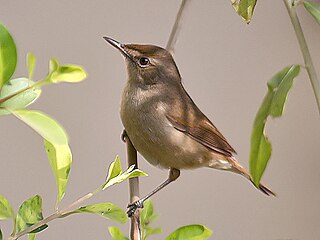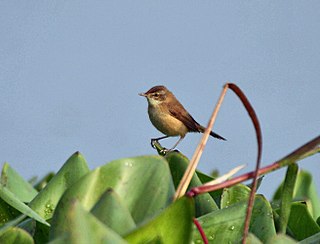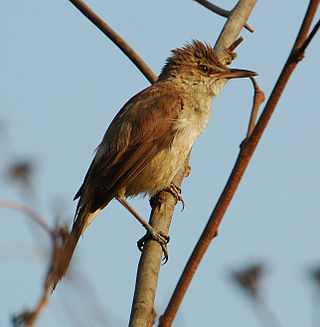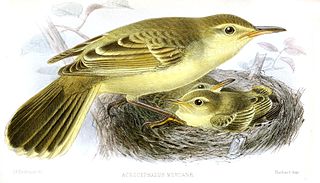
The Acrocephalus warblers are small, insectivorous passerine birds belonging to the genus Acrocephalus. Formerly in the paraphyletic Old World warbler assemblage, they are now separated as the namesake of the marsh and tree warbler family Acrocephalidae. They are sometimes called marsh warblers or reed warblers, but this invites confusion with marsh warbler and reed warbler proper, especially in North America, where it is common to use lower case for bird species.

The marsh warbler is an Old World warbler currently classified in the family Acrocephalidae. It breeds in temperate Europe and the western Palearctic and winters mainly in southeast Africa. It is notable for incorporating striking imitations of a wide variety of other birds into its song.

Blyth's reed warbler is an Old World warbler in the genus Acrocephalus. It breeds in the Palearctic and easternmost Europe. It is migratory, wintering in Bangladesh, India and Sri Lanka. It is one of the most common winter warblers in those countries. It is a rare vagrant to western Europe.

The great reed warbler is a Eurasian in the passerine genus Acrocephalus.

The paddyfield warbler is a species of marsh warbler. It was formerly included in the "Old World warbler" assemblage. The Manchurian reed warbler was included in A. agricola as a subspecies.

The Cape Verde warbler is an Old World warbler in the genus Acrocephalus. It is also known as the Cape Verde cane warbler or Cape Verde swamp warbler, and in Creole as tchota-de-cana or chincherote. It breeds on Santiago, Fogo, and São Nicolau in the Cape Verde Islands. It previously bred on Brava. This species is found in well-vegetated valleys, avoiding drier areas. It nests in reedbeds, two to three eggs being laid in a suspended nest.

The clamorous reed warbler is an Old World warbler in the genus Acrocephalus. It breeds from Egypt eastwards through Pakistan, Afghanistan and northernmost India to south China and southeast Asia. A. s. meridionalis is an endemic race in Sri Lanka.

The Tahiti reed warbler is a songbird in the genus Acrocephalus. It used to be placed in the "Old World warbler" assemblage (Sylviidae), but is now in the newly recognized marsh warbler family Acrocephalidae. It is endemic to the island of Tahiti.

The nightingale reed warbler, or Guam reed-warbler, is an extinct songbird that was endemic to Guam.

The Basra reed warbler is a "warbler" of the genus Acrocephalus. It is an endemic breeder in Southwestern Iran, East and southern Iraq, Kuwait, and Israel in extensive beds of papyrus and reeds. It is easily mistaken for the great reed warbler but is a bit smaller, has whiter underparts and has a narrower, longer and more pointed bill. It winters in East Africa. It is a very rare vagrant in Europe. The call is a gruff chaar, deeper than a reed warbler's.

The Acrocephalidae are a family of oscine passerine birds, in the superfamily Sylvioidea.

The black-browed reed warbler is a marsh-warbler in the family Acrocephalidae. It was formerly included in the "Old World warbler" assemblage. The species was first described by Robert Swinhoe in 1860.

The Cook reed warbler or Cook Islands reed warbler, is a species of Old World warbler in the family Acrocephalidae. It is native to the southeastern Cook Islands. Its natural habitats are subtropical or tropical dry forests, swamps, and rural gardens. It is threatened by habitat loss.

The Rimatara reed warbler is a species of Old World warbler in the family Acrocephalidae. It is found only in Rimatara in French Polynesia. Its natural habitats are subtropical or tropical dry forests and swamps. Due to its limited geographic distribution, this bird is classified as critically endangered on the International Union for Conservation of Nature (IUCN) Red List of Threatened Species.

The greater swamp warbler is a species of Old World warbler in the family Acrocephalidae. It is found in Angola, Botswana, Burundi, Cameroon, Central African Republic, Chad, Republic of the Congo, Democratic Republic of the Congo, Equatorial Guinea, Gabon, Ghana, Kenya, Mali, Mauritania, Namibia, Nigeria, Rwanda, Senegal, South Sudan, Tanzania, Togo, Uganda, Zambia, and Zimbabwe. Its natural habitat is swamps.

The speckled reed warbler or streaked reed warbler is an Old World warbler in the family Acrocephalidae. The species was first described by Robert Swinhoe in 1863.

The Henderson reed warbler, also known as the Henderson reed-warbler or the Henderson Island reed warbler, is a species of Old World warbler in the family Acrocephalidae. It is found only on Henderson Island, part of the Pitcairn Islands. Its natural habitat is subtropical or tropical dry forests. It is threatened by habitat loss.

The southern Marquesan reed warbler is a species of Old World warbler in the family Acrocephalidae.

The Saipan reed warbler is a critically endangered songbird of the Northern Mariana Islands.

The northern Marquesan reed warbler is a species of Old World warbler in the family Acrocephalidae. It was formerly considered conspecific with the southern Marquesan reed warbler, and together known as the Marquesan reed warbler. It is found on the northern Marquesas Islands.





















